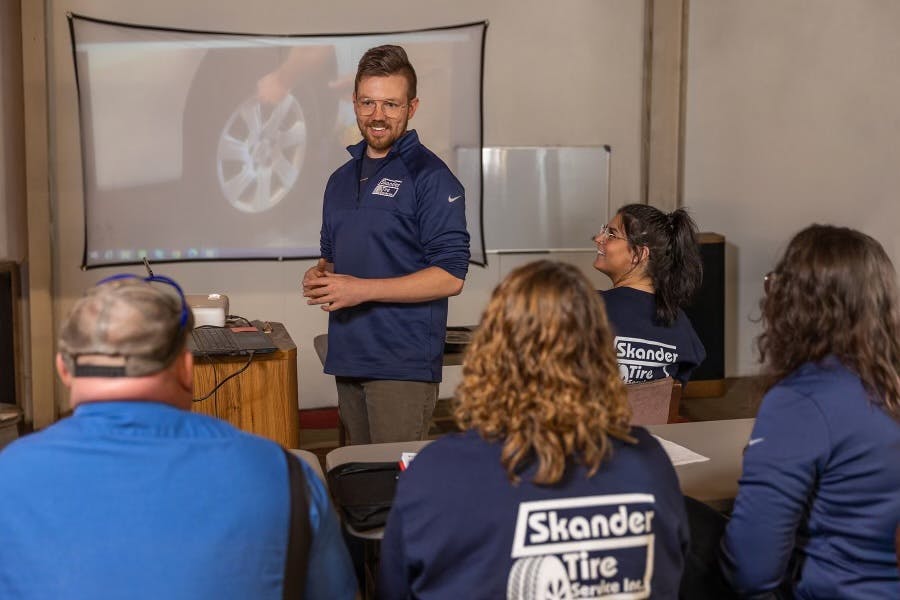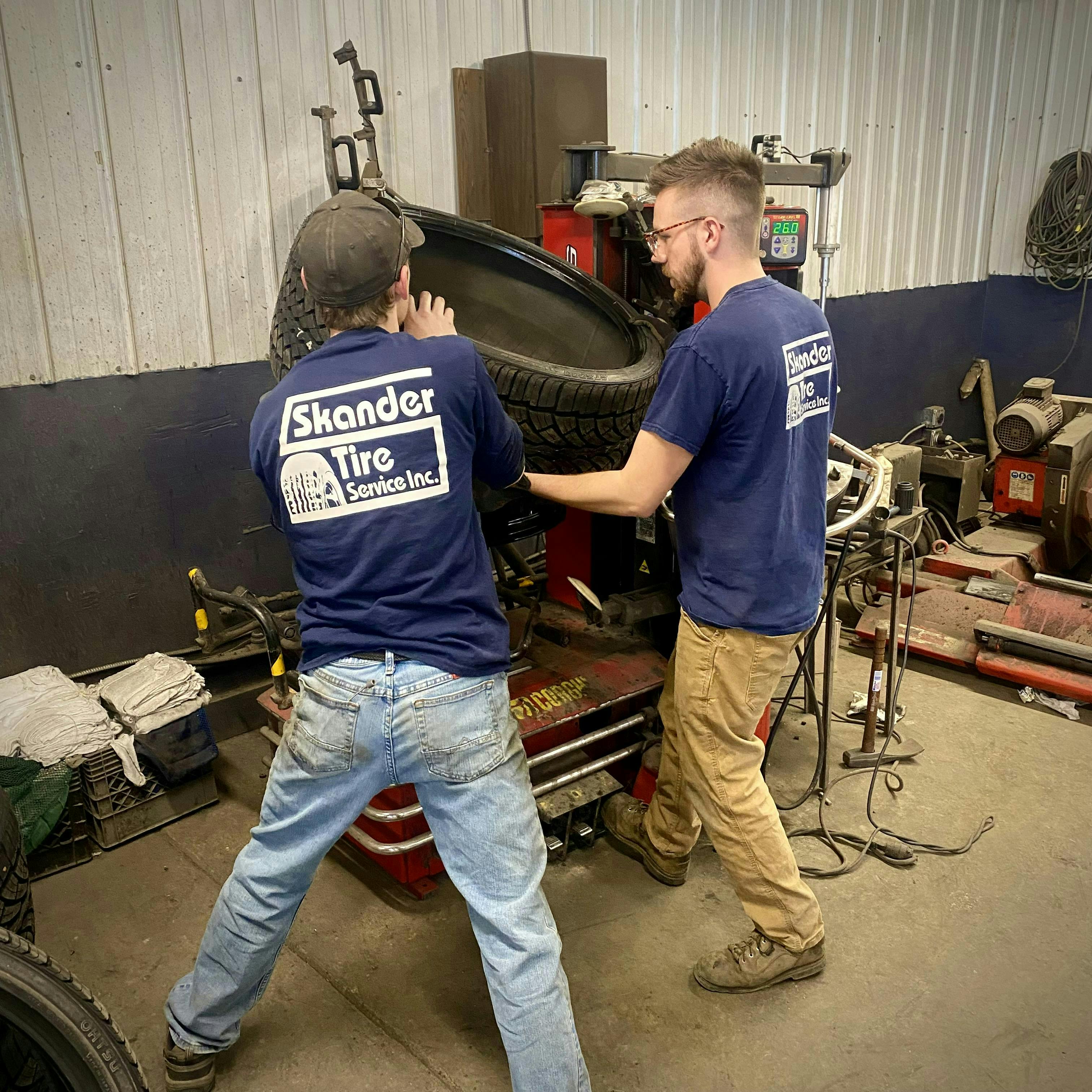Two years ago, Alex Skander, the owner of Skander Tire & Auto Service, received an application through Indeed from a person applying for a tire technician job.
Not thinking much of it, Skander brought the 19-year-old applicant, Jake Zanavich, in for an interview at his dealership's Evans City, Pa., location.
Before sitting down with Zanavich, Skander, gazing through his shop’s window, watched the young man speak in American Sign Language (ASL).
He then realized that Zanavich was hearing-impaired and was using ASL as his main form of communication.
“I’m pretty comfortable and open-minded with everything, but there was a moment when I was looking out the front window and saw him signing to someone else and thought to myself, ‘Oh man, what did I sign up for? No one on my team knows ASL,” says Skander.
“It never crossed my mind to turn him away, but there was a moment of panic where I thought, ‘OK. How am I going to tackle this?’”
Skander invited Zanavich into his office. They conducted the interview by typing back and forth to each other via the Notes app on their smartphones.
Skander says he quickly determined that Zanavich, who had previously worked for another tire dealership, had a great attitude and energy, in addition to the required technical experience.
By the end of the day, Zanavich was hired onto the Skander Tire & Auto Service team.
“I hired him without knowing how we were going to be able to communicate with him,” says Skander. “I just figured we would figure it out. My crew is relatively young and open-minded so I figured it would be fine.”
Skander’s employees came up with the idea to order several small, dry erase boards and markers from Amazon and placed those around the dealership.
Whenever someone needed to communicate with Zanavich or vice versa, they could grab a whiteboard and write it out.
Texting on phones and utilizing the Notes app also have been effective forms of communication.
‘Not a huge issue’
The way Skander Tire & Auto Service operates made Zanavich’s assimilation into the dealership “not a huge issue,” according to Skander.
Skander says a lot of the communication at his store is nonverbal to begin with. His team already was using a tool that he calls “a floor sheet.
“Basically, the service writer will, in addition to writing up a work order at the front counter, go into an Excel document and write the customer's name, which service advisor they will get, how many tires they need and the type of tires they need,” he explains.
“This Excel sheet with all this information is then projected onto a big screen in the garage so that all the technicians know what is about to come in five cars from now, so there are no surprises.”
Zanavich, in describing his early days at Skander Tire & Auto Service, says that he was surprised at how enthusiastically and quickly his co-workers found ways to communicate with him.
“I was impressed because many companies reject deaf people.”
Learning a new language
Skander even took it a step further. “It was pretty promptly after we hired Jake that we started ASL classes,” he says.
Skander’s cousin, who is also the human resources manager at the dealership, knew someone at a local community college who teaches ASL.
“This is why I take no credit for this,’ he explains. “It all just kind of happened (because of) the people around me.”
The instructor agreed to come in and hold a class every Wednesday in the waiting room of Skander Tire & Auto Service, going over the basics of ASL. Skander says the cost to his company was “basically nothing.
“I paid her (and) I paid for the textbooks and put a notice out on Facebook for anyone who wanted to come,” even from outside the dealership. “We had a handful of people show up.”
Classes were not mandatory for Skander Tire & Auto Service employees, but around a dozen employees would show up to each class.
Skander says he and his employees who don't have a hearing disability now often use ASL when communicating with each other.
“We have segments of the building that are separated by glass windows and you can’t hear through them, so sometimes I will just sign the information through the window to my employees.”
Skander Tire has 11 service bays.
Zanavich says he and his co-workers can now “fluently talk to each other with no problems,” without the use of whiteboards or apps.
Patience is a virtue
Skander is modest when discussing the adjustments he made to accommodate Zanavich. “This story is not about me or my business and I don’t want to use this (article) for the wrong purposes,” he says.
His advice to other tire dealers who have the opportunity to hire an employee with a hearing disability is to be patient, adding that his recommendations “would be the same if you were guying to hire ... anyone who has a different ability, a different language or a different viewpoint than you: just take it slowly.”
Zanavich agrees that patience is the key and also says it comes down to a tire dealer’s trust in his or her employees.
“Alex puts 100% trust (in us) every day and I’ll put 120% in every day because I want to prove to Alex that I’m not a burden and it really worked and now I’m doing things that I love,” he says. “There are so many barriers waiting for us, but if you are alongside (us), you’ll help us break those down.
“As a deaf person, the tire industry is hard because people don’t give you the benefit of the doubt. Please give people with disabilities the benefit of doubt. I promise it’ll be worth it because you’ll end up having a loyal employee who will never leave.”
Zanavich says he wants to continue to grow his career at Skander Tire & Auto Service by learning more about truck service and other areas. “Deaf people are fully capable of doing tires and mechanical work.
“Just because we can’t hear doesn’t mean we can’t learn. Teach and you’ll be rewarded.”





